A Fire Lookout On What's Lost In A Transition To Technology
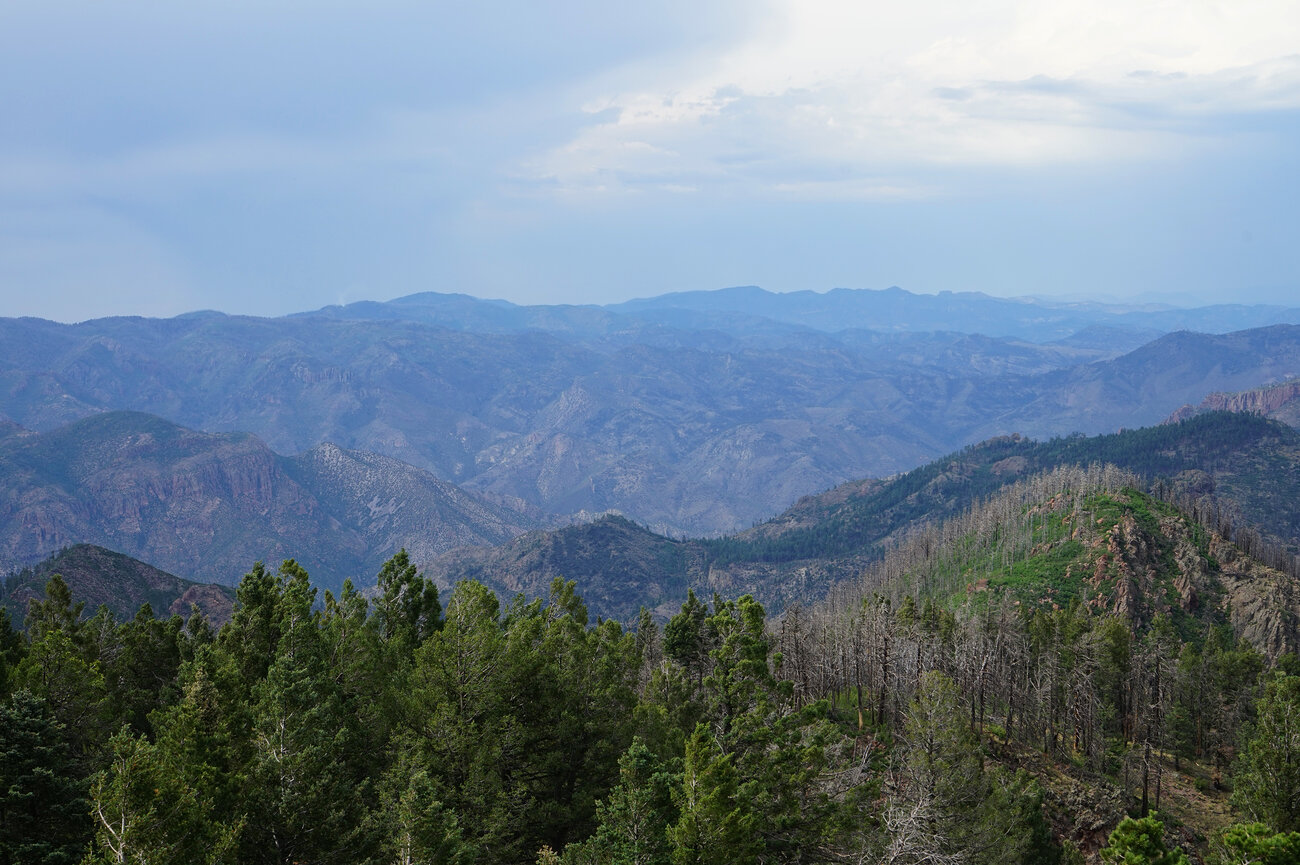
A single tree burns in southwest New Mexico after a lightning strike. For more than 100 years, the U.S. Forest Service has been posting men and women atop mountains and trees, and in other hard-to-reach places, to wait and watch for smoke.
Can you see it? The fire in the photo above?
A single tree burning doesn't put up much smoke.
There's a flash of lightning, sizzling across the sky. Then a pause as bark smolders and flames creep, building heat until poof: a signal in the sky.
Philip Connors, gazing outward from a tower, sees it as a new dent on the crest of a distant ridge. He's spent thousands of hours contemplating the contours of southwest New Mexico. The fuzzy smudge is out of place.
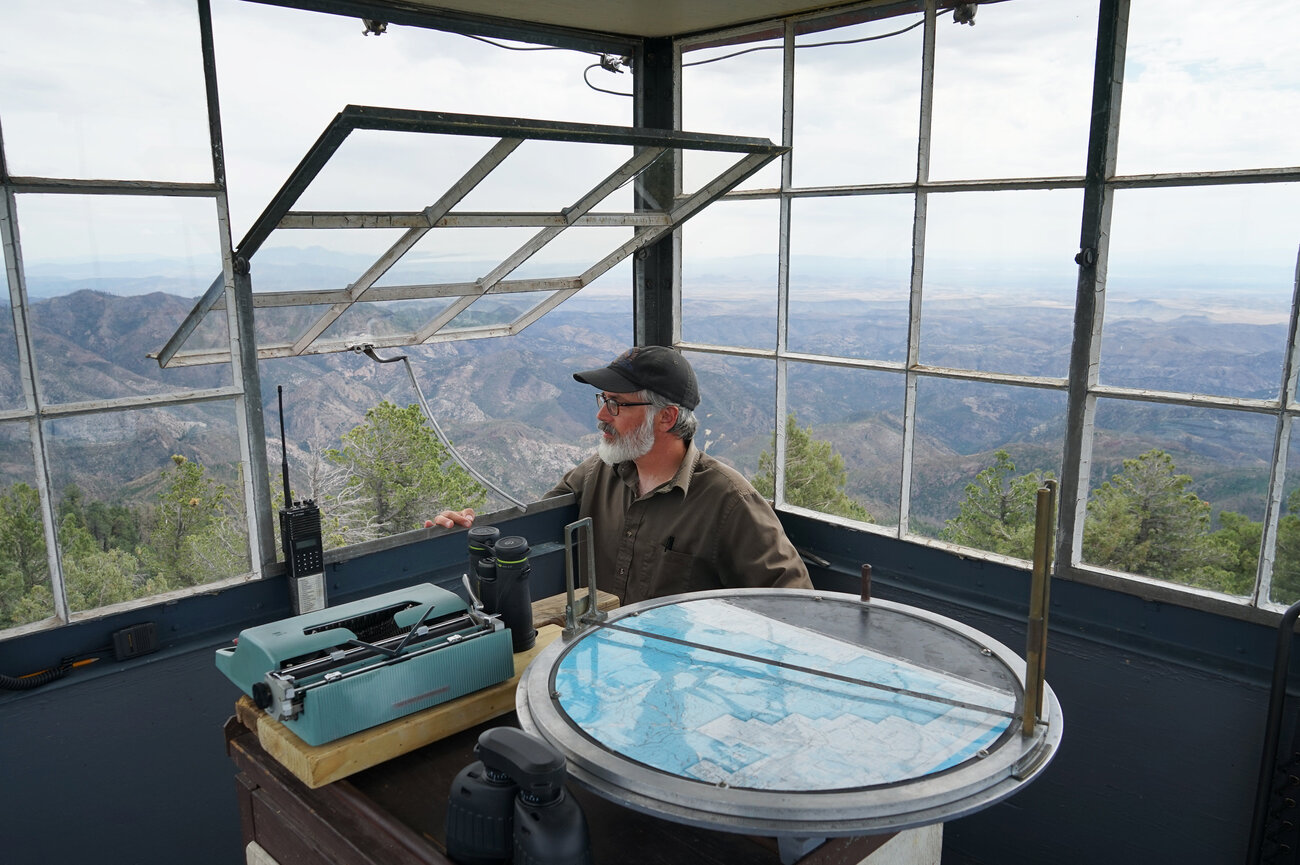
Philip Connors has spent 17 summers as a fire lookout in the Gila National Forest. Lookouts are the eyes in the forest, even as the forests they watch have changed, shaped by developers, shifting land management policies and climate change.
Connors is a fire lookout, and as such, he's paid to notice small, faraway things.
For more than 100 years, the U.S. Forest Service has been posting men and women atop mountains and trees, and in other hard-to-reach places, to wait and watch for smoke. They're the eyes in the forest, even as the forests they watch have changed, shaped by developers, shifting land management policies and climate change. At times, fire lookouts were part of that change. At times, they critiqued it.
But in recent years, the number of active lookouts has dwindled from thousands to hundreds as technology has encroached.
Why pay a person to sit on top of a mountain when you can plop down a 360-degree camera? Why try to discern a fire's heat and intensity from the color of its smoke when you can get an infrared image? Why pay Connors to plot a fire's location with a faded map, a line of string and a pair of binoculars, when you can get a precise location from drone Unmanned 201?
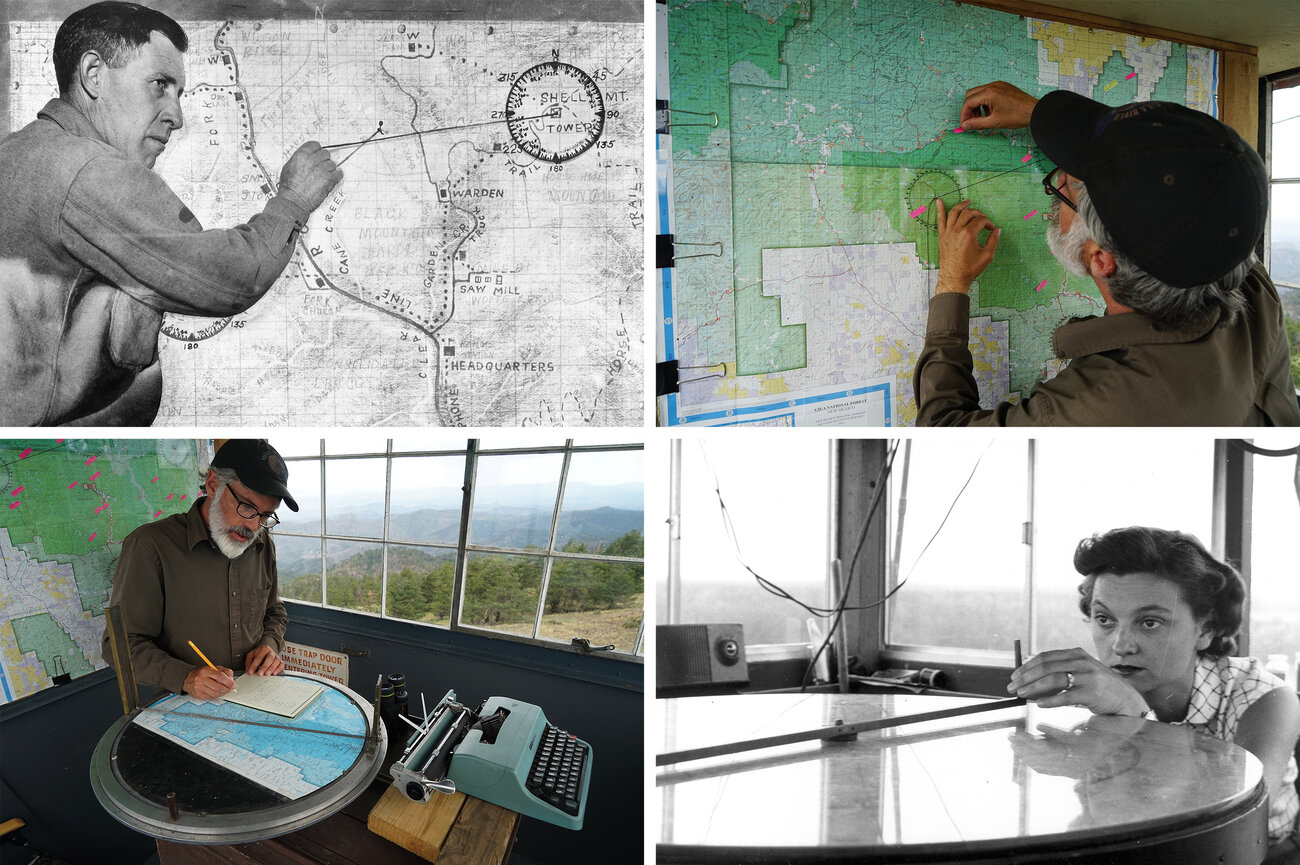
Upper left: A lookout demonstrates how to find the approximate location of a fire after two towers have reported seeing smoke in 1936. Upper right: Connors marks a map of the area. Lower right: A fire lookout uses a fire finder at a Delaware fire tower in 1943. Lower left: Connors consults a fire finder while writing in his notebook.
That drone, a solar-powered Silent Falcon, was launched earlier in the morning. It's part of a short-term experiment land managers are trying in New Mexico's Gila National Forest to spot and monitor fires.
Perched inside his glass box, above the surrounding pines, the radio squawks and Connors jots notes on a legal pad.
"The LRZ is hot. The launch and recovery zone. These are literally phrases I have never copied down in 17 years until 48 hours ago," he says. "So yeah, the future is here apparently and I'm watching it."
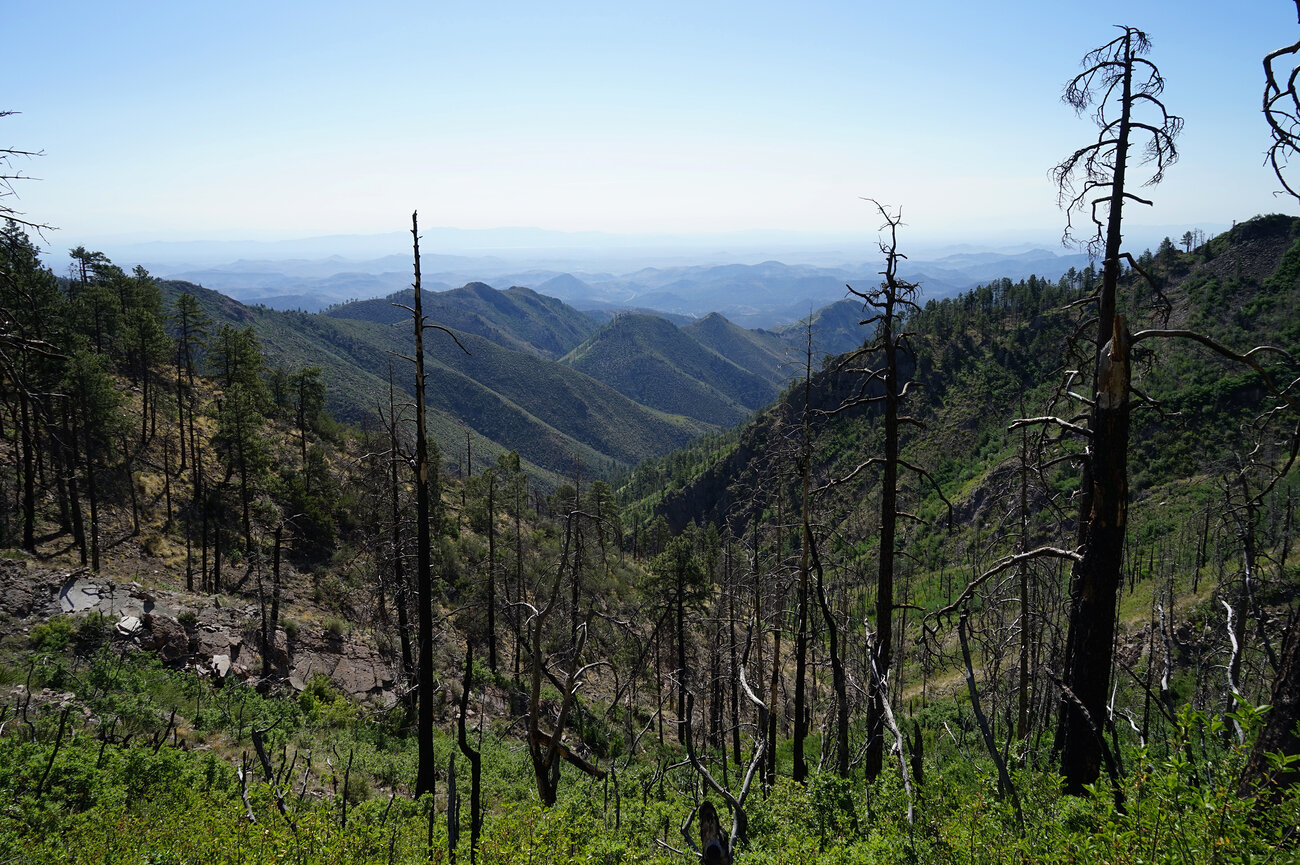
Fire damage in the Gila National Forest. Lookouts serve as eyes and as a communication link for fire crews working in the region's rugged terrain.
There's a certain pragmatism that grows out of living alone on a mountain for every summer, away from people, power and roads.
If you're thirsty, you fetch water from the missile-container-turned-cistern buried outside. If you're hungry, you cook the food you had packed in weeks earlier by mule. And if you're bored with nothing but the birds and clouds, well, you might want to take some time during your four bi-weekly days off to find another job.
Connors has spent 17 summers as a fire lookout in the Gila National Forest. His white beard frames a face tanned by the southern New Mexico sun. He's as pragmatic a person as you'll find.
So when hikers stumble upon his lookout tower, a 50-foot monolith perched atop a flat peak, he's never surprised or mean when he gets asked the same questions: What about satellites? What about drones?

Connors stands in the lookout tower. In recent years, the number of active lookouts has dwindled from thousands to hundreds as technology has encroached.
"I often feel I'm in a position of having to defend my very existence here," he says. "People just sort of assume that the technology has advanced to a point where it would make me totally obsolete."
There are, he says, many things he can do that a drone can't. He can sit in a tower for an entire day, watching and studying a fire's behavior. He can serve as eyes and as a communication link for fire crews working in the region's rugged terrain. He can apply his experience to put a fire in context and communicate about it in ways only a human can.

Connors looks through his binoculars. He's spent thousands of hours contemplating the contours of southwest New Mexico.
"At $14 and change an hour, I'm also pretty cheap," he says.
Supervisors say the drone, with its support staff and operators, can be prohibitively costly. But with that cost comes advantages.
"For one thing, I can't hover over that fire, so it's got me beat there," Connors says, nodding to the distant smoke.
Connors' view is from a distance of about 15 miles, with valleys, ridges and mountains between. The tools at his disposal — binoculars, maps and notebooks — have gone virtually unchanged since the first fire lookouts were built on high peaks with unobstructed views in the early 1900s. The circular mapping tool at the center of Connors' tower, which he uses to get a bearing on the fire, went into service a few years after the Titanic sank.
In those early days, fire lookouts were also firefighters. They'd spot, locate and extinguish fires as quickly as possible. That ad hoc approach became federal policy following the Big Blowup of 1910, when a series of wildfires tore across Idaho, Montana and Washington, killing at least 85 people and sending smoke as far as New England.
The conflagrations cast wildfire as a national threat and gave the fledgling U.S. Forest Service a mission: to remove wildfire from the landscape altogether. The best way to stop a fire is to catch it early. Lookouts were the instrument of choice.
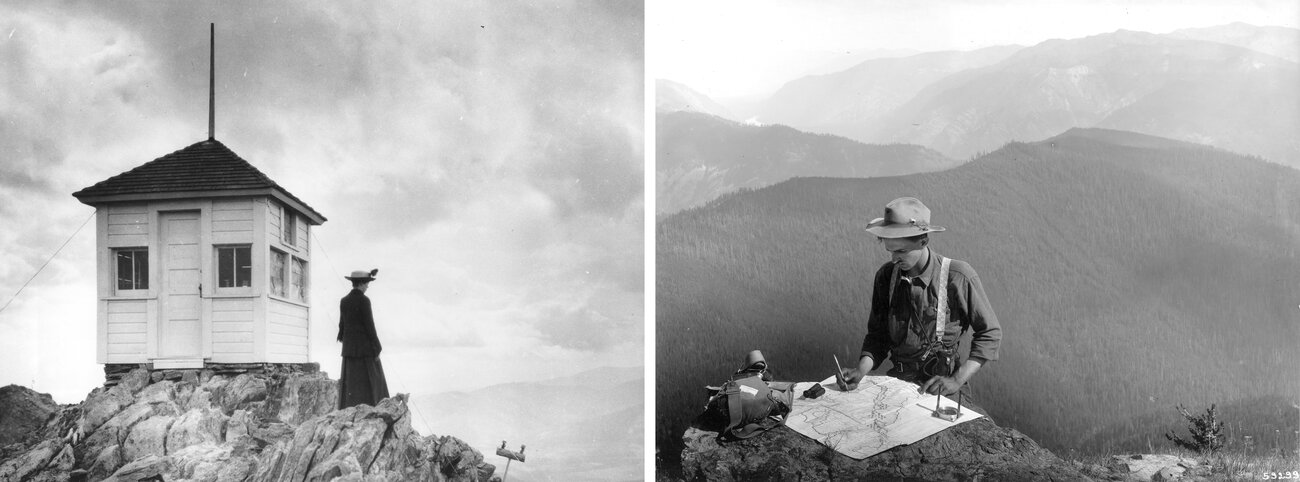
Left: A fire lookout stands next to the Twin Sisters lookout station in Colorado in 1917. Right: Forest Ranger Griffin locates the distance of a forest fire on a map near the Mt. Silcox lookout station in Montana in 1909.
Nearly 250 lookout stations were built in the next two years. Thousands more followed. Connors' tower, a weather-stained stack of steel, glass and wood, was erected in 1933. By the 1950s there were more than 5,000 permanent lookout towers, mostly in the timber-rich West.
Lookouts and their towers had become Smokey Bear-like symbols of the nation's ability to control the environment. They were the guardians of the forest, living in isolation in an ever-shrinking American wilderness.
That romanticism, the promised quiet and a modest paycheck attracted a host of literary greats to the profession of watching forests. Connors, who's a writer himself, says it's like a "paid writing retreat with good views."

In the early 1900s, fire lookouts were also firefighters. They'd spot, locate and extinguish fires as quickly as possible.
American authors Norman Maclean, Gary Snyder, Jack Kerouac and Edward Abbey all spent summers as fire lookouts.
"The technical aspects of a lookout's job can be mastered by any literate anthropoid with an IQ of not less than 70 in about two hours," Abbey wrote in the essay Fire Lookout: Numa Ridge, published in 1977. "It's the attitude that's difficult: Unless you have an indolent, melancholy nature, as I do, you will not be happy as an official United States government fire lookout."
Abbey's experience as a lookout in the southwest and in Montana helped shape some of his most famous works, which, in turn, helped shape the public's evolving view of wilderness and wildfire.
Connors, who left a job at The Wall Street Journal in New York City to become a lookout, sees himself as part of that tradition. A teal Olivetti Lettera typewriter sits next to a pair of binoculars in his 49-square-foot tower.

Connors has written three books during his time as a lookout. A teal Olivetti Lettera typewriter sits next to a pair of binoculars in his 49-square-foot tower.
His first book, 2011's Fire Season: Field Notes from a Wilderness Lookout, documents a season on the mountain and explores the nation's complicated history with wildfires. It won Connors a National Outdoor Book Award. He's since had two other books published, exploring loss and his time as a lookout.
"Every culture should have a couple of outsiders bringing a message from outside of the dominant culture," Connors says. "I'd like to think there's something I too can add to the way we view the world."
The Gila National Forest, where Connors works, is an outlier in a lot of ways. Ten lookouts are still regularly staffed each summer. Many are veterans like Connors.
Elsewhere, lookouts are being replaced. Drones are being increasingly used on wildfires. Satellites track smoke. In Oregon and parts of California, high-tech cameras allow land managers to scan distant horizons from the comforts of their home or office. Lookout towers across the country are being torn down, left to decay or converted into rental properties.

The Gila National Forest, where Connors works, is an outlier in a lot of ways. Ten lookouts are still regularly staffed each summer. Many are veterans like Connors.
A survey by the Forest Fire Lookout Association estimates that only about 300 fire lookout towers are still manned today, many by volunteers.
Adam Mendonca, the forest supervisor in the Gila, says he doesn't expect Connors' job to be replaced by a camera or drone soon, but it's important for his agency to look at new technologies that will reduce human exposure to risk in the future.
There's risk associated with stationing people deep in the wilderness, he says. Limited access means limited options in the event of an emergency. Connors and other lookouts have had to be evacuated from oncoming fires by helicopter.
Before he left, Connors says, "the flame lengths [of the fire] were so long it looked like lava was spewing out of some volcano."
But Mendonca still values having human lookouts watching over his forests.
"They bring with them a sense of understanding and the ability to help frame up and communicate what all of this looks like — the big picture that you definitely don't get with a camera," he says.
Plus, he says, "they're just cool."

Connors watches hummingbirds visit a feeder near the tower. A survey by the Forest Fire Lookout Association estimates that only about 300 fire lookout towers are still manned today, many by volunteers.
The sun is on its downward climb, casting new shadows and new light on the surrounding mesas and mountains, and Connors is still in his lookout tower, gazing outward.
"The landscape has had six or eight different moods today," he says.
More smoke is rising off the fire he spotted earlier in the day, but not so much as to be alarmed. This forest — like many — evolved with fire, and land managers in the Gila National Forest are keen to let it reclaim its role on the landscape.
Hermit thrush and broad-tailed hummingbirds trill. Connors adjusts the faded black baseball cap on his head and says he knows there may come a day when digital intelligence can spot a distant fire, place it in the greater context of the land and make a narrative out of it for others to hear, see or read, replacing him completely.
"Humans throughout our culture are going to be replaced by various forms of automation going forward. It's happening now and it's going to accelerate," he says. "But I think we do ourselves a disservice if we don't at least stop and ask for half a second: What will we lose in that move towards automation?"
The radio squawks. Fire crews are finishing their shifts on a fire to the northwest.
"Here I think we lose some deeper wisdom and connection with the landscape," he says.

The sun sets over the Gila National Forest. Adam Mendonca, the forest supervisor in the Gila, says he doesn't expect Connors' job to be replaced by a camera or drone soon, but it's important for his agency to look at new technologies that will reduce human exposure to risk in the future.
And that, he says, should carry a great value now, more than ever.
"It doesn't matter how virtual we get," he says. "We're all still going to have to live in a world defined by weather. And my desperate hope is that we wake up in time to realize that our actions are impacting all of the nonhuman world as well."
--
Groups.io Links:
You receive all messages sent to this group.
View/Reply Online (#32362) | Reply To Group | Reply To Sender | Mute This Topic | New Topic
Your Subscription | Contact Group Owner | Unsubscribe [volcanomadness1@gmail.com]

No comments:
Post a Comment